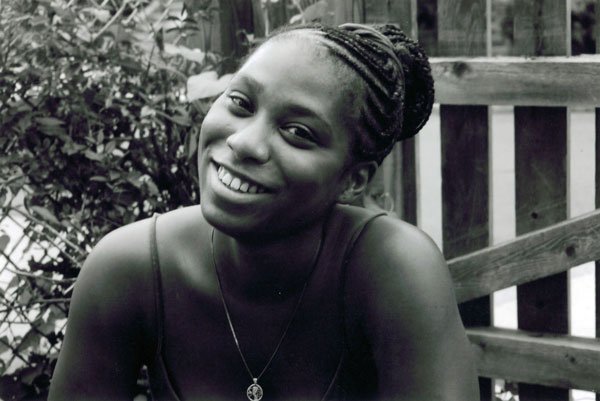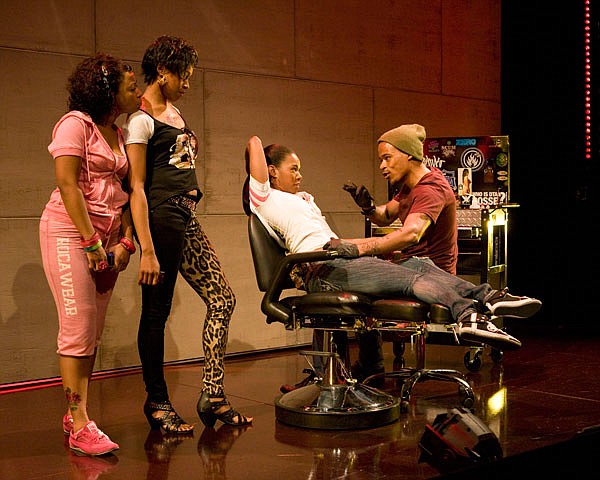 Facebook
Facebook
 X
X
 Instagram
Instagram
 TikTok
TikTok
 Youtube
Youtube

Playwright Kirsten Greenidge does not use the restroom during intermission when her plays are performed. “I get so wary about what I’m going to overhear,” she admits. “You have no voice in that situation. You can’t pick a fight in the restroom.”
This policy may have proven sound during the recent run of her controversial play Milk Like Sugar, at the La Jolla Playhouse from late August through September 25.
“During previews, before the play even opened,” Greenidge says, “[the Playhouse] started getting emails from people who were concerned about stereotypes and black characters.”
In 2008, the La Jolla Playhouse and Theater Masters in Aspen, Colorado, co-commissioned Greenidge to write a play. Together, the two institutions sent her to the Aspen Ideas Festival, where she participated in a week of seminars to generate ideas for the play. From 2009 to 2011, Greenidge traveled back and forth between Boston (where she resides) and New York to workshop the play, discussing choices she’d made, tweaking scenes, and developing characters, all of whom are, like herself, black.
In late August of this year, Milk Like Sugar premiered onstage at La Jolla Playhouse.

The advert posted on the Playhouse website reads, “Like all teenagers, 16-year-old Annie and her friends crave the hottest designer phones, handbags and fashion. But their prospects for the good life seem limited in the dead-end town they call home. When the girls decide to create their own future by entering into a pregnancy pact, Annie is confronted with the challenge of choosing between the safety of the life she knows and the danger of the life she desires.”
Greenidge says she and the actors discussed the idea of how these young, black urban characters would be perceived by the Playhouse’s mostly white, older, affluent audience. And although Playhouse managing director Michael Rosenberg says complaints came from an ethnically diverse range of audience members, it became clear that some of the more vocal critics were from the black community.
On September 8, the San Diego Voice and Viewpoint published a letter to the editor in which 73-year-old Dr. Dorothy Smith, the first African-American woman to be elected to public office in the city of San Diego (serving twice as president of San Diego Unified’s school board), wrote, “This play does not mirror life in the Black communities. It is filled with the kind of stereotypes that some White people like to perpetuate regarding Black people.”
Dea Hurston, one of two black commissioners on the City of San Diego’s Commission for Arts and Culture, read Dr. Smith’s letter before she saw the play. Hurston, who is also a longtime volunteer at the Playhouse, spoke outside her role of commissioner when she said, “I was pleasantly surprised that I did understand the play. I guess I viewed it in a different way [than Dr. Smith].”
Hurston’s friend Sherry Tyson saw the play during a visit to San Diego from Youngstown, Ohio, where she resides and works for the Youngstown City School District.
“[Greenidge’s] play was about young black girls with foul mouths, and the only things they could think about were their cell phones and getting Gucci bags at a baby shower,” Tyson says. “I think this is what white people believe happens in homes where there’s maybe a single parent, but I know for a fact that’s not always what happens.”
Philip Liburd, a vice president at the local branch of the NAACP, found the play to be “well-written and relevant.” He says, “I didn’t think that the play was in any way meant to represent all African Americans or all young black kids.”
Greenidge says this is not the first time she’s been criticized for these characters. When she first began writing the play, another black female playwright told her she didn’t like these young characters and didn’t care to know what they wanted. Greenidge decided then that she would “write the hell out of these girls” and give them a place on the stage.
“The message I’m getting is that girls like this — and I know they exist — don’t deserve to be onstage and be seen. And that there are other stories to put onstage, other more hopeful or better characters,” Greenidge says. “Not every play is going to be about Rosa Parks or Martin Luther King or Sojourner Truth. And I also think we owe it to ourselves as a people to look at other stories besides those.”
Another complaint that came up: right play, wrong theater.
“I think it’s fair to say that there were people in the community who think something like this should be done in the black community,” says Liburd.
Referring to Dr. Smith’s letter to the editor, Hurston explains, “I think something that Dorothy worried about with that was that white people will think that’s how we really are. Or, rather, that that’s how they will think we only are.”
And though Hurston understands why this fear would resonate through the community, she also says, “It isn’t art if there isn’t criticism. And for me, this piece has just caused so much discussion. I love it. I applaud the Playhouse for being brave enough to commission this piece. Here we have a black female playwright who has had her play commissioned and produced at one of the finest regional theaters in the country. How bad can this be?”
Greenidge spent the month of October tweaking the play before its Off Broadway run in New York. When asked if any changes are the result of criticisms she heard in San Diego, Greenidge says, “No. This play has been through so much development and so many readings where as a writer you just sit there and take notes for two hours, over and over and over again. So, even though it upsets people, I’m confident in what the play is saying.”


Playwright Kirsten Greenidge does not use the restroom during intermission when her plays are performed. “I get so wary about what I’m going to overhear,” she admits. “You have no voice in that situation. You can’t pick a fight in the restroom.”
This policy may have proven sound during the recent run of her controversial play Milk Like Sugar, at the La Jolla Playhouse from late August through September 25.
“During previews, before the play even opened,” Greenidge says, “[the Playhouse] started getting emails from people who were concerned about stereotypes and black characters.”
In 2008, the La Jolla Playhouse and Theater Masters in Aspen, Colorado, co-commissioned Greenidge to write a play. Together, the two institutions sent her to the Aspen Ideas Festival, where she participated in a week of seminars to generate ideas for the play. From 2009 to 2011, Greenidge traveled back and forth between Boston (where she resides) and New York to workshop the play, discussing choices she’d made, tweaking scenes, and developing characters, all of whom are, like herself, black.
In late August of this year, Milk Like Sugar premiered onstage at La Jolla Playhouse.

The advert posted on the Playhouse website reads, “Like all teenagers, 16-year-old Annie and her friends crave the hottest designer phones, handbags and fashion. But their prospects for the good life seem limited in the dead-end town they call home. When the girls decide to create their own future by entering into a pregnancy pact, Annie is confronted with the challenge of choosing between the safety of the life she knows and the danger of the life she desires.”
Greenidge says she and the actors discussed the idea of how these young, black urban characters would be perceived by the Playhouse’s mostly white, older, affluent audience. And although Playhouse managing director Michael Rosenberg says complaints came from an ethnically diverse range of audience members, it became clear that some of the more vocal critics were from the black community.
On September 8, the San Diego Voice and Viewpoint published a letter to the editor in which 73-year-old Dr. Dorothy Smith, the first African-American woman to be elected to public office in the city of San Diego (serving twice as president of San Diego Unified’s school board), wrote, “This play does not mirror life in the Black communities. It is filled with the kind of stereotypes that some White people like to perpetuate regarding Black people.”
Dea Hurston, one of two black commissioners on the City of San Diego’s Commission for Arts and Culture, read Dr. Smith’s letter before she saw the play. Hurston, who is also a longtime volunteer at the Playhouse, spoke outside her role of commissioner when she said, “I was pleasantly surprised that I did understand the play. I guess I viewed it in a different way [than Dr. Smith].”
Hurston’s friend Sherry Tyson saw the play during a visit to San Diego from Youngstown, Ohio, where she resides and works for the Youngstown City School District.
“[Greenidge’s] play was about young black girls with foul mouths, and the only things they could think about were their cell phones and getting Gucci bags at a baby shower,” Tyson says. “I think this is what white people believe happens in homes where there’s maybe a single parent, but I know for a fact that’s not always what happens.”
Philip Liburd, a vice president at the local branch of the NAACP, found the play to be “well-written and relevant.” He says, “I didn’t think that the play was in any way meant to represent all African Americans or all young black kids.”
Greenidge says this is not the first time she’s been criticized for these characters. When she first began writing the play, another black female playwright told her she didn’t like these young characters and didn’t care to know what they wanted. Greenidge decided then that she would “write the hell out of these girls” and give them a place on the stage.
“The message I’m getting is that girls like this — and I know they exist — don’t deserve to be onstage and be seen. And that there are other stories to put onstage, other more hopeful or better characters,” Greenidge says. “Not every play is going to be about Rosa Parks or Martin Luther King or Sojourner Truth. And I also think we owe it to ourselves as a people to look at other stories besides those.”
Another complaint that came up: right play, wrong theater.
“I think it’s fair to say that there were people in the community who think something like this should be done in the black community,” says Liburd.
Referring to Dr. Smith’s letter to the editor, Hurston explains, “I think something that Dorothy worried about with that was that white people will think that’s how we really are. Or, rather, that that’s how they will think we only are.”
And though Hurston understands why this fear would resonate through the community, she also says, “It isn’t art if there isn’t criticism. And for me, this piece has just caused so much discussion. I love it. I applaud the Playhouse for being brave enough to commission this piece. Here we have a black female playwright who has had her play commissioned and produced at one of the finest regional theaters in the country. How bad can this be?”
Greenidge spent the month of October tweaking the play before its Off Broadway run in New York. When asked if any changes are the result of criticisms she heard in San Diego, Greenidge says, “No. This play has been through so much development and so many readings where as a writer you just sit there and take notes for two hours, over and over and over again. So, even though it upsets people, I’m confident in what the play is saying.”
Comments